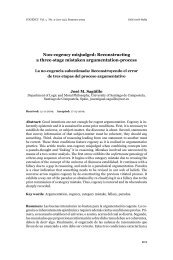Cogency v2 n2
Cogency v2 n2
Cogency v2 n2
Create successful ePaper yourself
Turn your PDF publications into a flip-book with our unique Google optimized e-Paper software.
COGENCY Vol. 2, N0. 2, Spring 2010<br />
the means/ends balance in the analysis of normatively desirable argumentative<br />
conduct, which “cannot be oriented only to the analysis of argumentative<br />
devices themselves, but rather must be situated within a broader understanding<br />
of the larger ends sought” (p. 88).<br />
Looking at this volume, interdisciplinarity could be also intended – in a<br />
broader sense – in a longitudinal understanding as a dialogue with the past<br />
and, in particular, with the tradition of classical rhetoric and the medieval<br />
reflection on logic and argumentation. We do not stand on the shoulder of<br />
giants inactively; we are also able to pursue a “dialogue” with them, criticize<br />
them and inherit what is relevant to current argumentation studies. In particular,<br />
D. Jaquette (Ch. 8) analyses and criticizes a provoking but fallacious<br />
reasoning, proposed in 1323 by Walter Burleigh in his De puritate<br />
artis logicae tractatus longior (Longer Treatise on the Purity of Logic). M.<br />
Kraus (From figure to argument: contrarium in Roman rhetoric, Ch. 9)<br />
takes us some centuries back to analyse the concept of the “contrarium”<br />
argument. Considering different texts – from the Rhetoric to Herennius to<br />
Ciceros’ and Quintilian’s rhetorical works – contrarium seems to oscillate<br />
between a proper type of argument and a rhetorical figure pertaining to the<br />
domain of presentational devices. In The duties of advocacy: argumentation<br />
under conditions of disparity, asymmetry and difference (Ch. 19), G.<br />
T. Goodnight provides a rich overview of the role of advocacy, from the<br />
classical world (Greece and Rome) to the contemporary one. Thanks to<br />
Goodnight’s critical analysis and via the history of a concept like advocacy,<br />
we are brought to understand contexts and forms of argumentation through<br />
time; the result is a vivid picture of the goals and expectations surrounding<br />
advocates living in very different historical periods, from Pericles (p. 272)<br />
to the American pioneers (pp. 275-276) or Lady Diana (p. 280).<br />
The indirect question that motivates the title to Rigotti’s contribution,<br />
Whether and how classical topics can be revived within the contemporary<br />
argumentation theory (Ch. 12), explicitly refers to the kind of longitudinal<br />
interdisciplinarity I have tried to sketch. Rigotti aims at proposing a contemporary<br />
model of argument schemes (topics), well grounded in argumentation<br />
studies; yet this model stems from consideration of classical and<br />
medieval contributions to a model of topics. This is reflected in the typology<br />
of loci he presents (p. 168) as well as in the analysis of the inferential structure<br />
of single argumentations (pp. 170 and 173). In both cases, past ap-<br />
184








